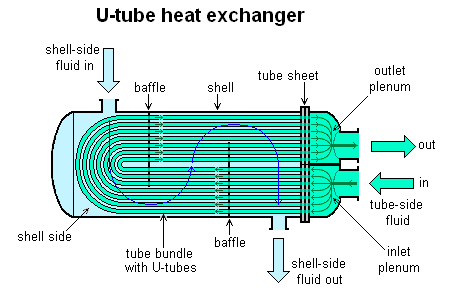

However that means that the heat transfer coefficient U changes (if for example the speed becomes too low then the flow becomes laminar and the heat exchange is significantly affected). Depending on the case, $Nu\propto Re^n$ where n is a number ranging from 0.5 to 1. The Reynolds number affects the Nusselt number which control the convection. Shell and tube heat exchanger is a device where two working fluids exchange heats by thermal contact using tubes housed within a cylindrical shell. Round fins on the outside of the tube are used on the gas side of. Two fluids can exchange heat, one fluid flows over. Figure 1 illustrates a typical unit that may be found in a petrochemical plant. A shell and tube exchanger consists of a number of tubes mounted inside a cylindrical shell. That will affect the flow in the shell.īecause of those changes, then the Reynolds number might change. Conventional Tube-Fin heat exchangers are most commonly used in gas-to-liquid applications. Regardless of the type of industry the exchanger is to be used in there are a number of common features (see Condensers). Mass flow rate is the mass of a substance that passes per unit of time. However, the problem is that the following, by changing the number of pipes, you are changing the internal configuration. The Number of tubes in transverse fin heat exchanger formula is defined as the count of how many tubes are required for the heat exchanger and is represented as N m/ (GTPh) or Number of tubes Mass Flow Rate/ (Mass fluxDistance between two consequent tubesHeight). A good text is 'Heat Exchanger Design and Theory Sourcebook' by Afgan & Schlunder. half the heat transferred, would reduce the temperature of half the flow.). Most large steam condensers used in a power plant have ten times this many tubes. Although, if you reduce to half the flow rate then the average speed on the tubes will halve, and things should be ok (i.e.

Since you have only half the transmitted heat energy, the seemingly obvious solution would be to reduce by half the flow rate of the cooled liquid (the one coming in at 100 $^oC$). If I remove half the tubes can I get the same temperature difference? heat exchanger dimensionless groups the number of heat transfer units. As a result because the heat exchange will be less, the out temperature will be closer to the input temperatures. temperatures in fin-and-tube heat exchangers subject to airflow nonuniformity. In that case like you mentioned the exchange surface will halve, and that will reduce the heat exchange.



 0 kommentar(er)
0 kommentar(er)
